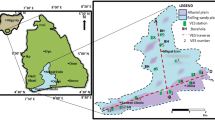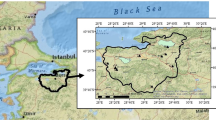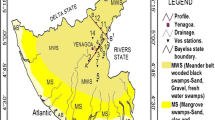Abstract
The relationship between aquifer hydraulic conductivity and aquifer resistivity, either measured on the ground surface by vertical electrical sounding (VES) or from resistivity logs, or measured in core samples have been published for different types of aquifers in different locations. Generally, these relationships are empirical and semi-empirical, and confined in few locations. This relation has a positive correlation in some studies and negative in others. So far, there is no potentially physical law controlling this relation, which is not completely understood. Electric current follows the path of least resistance, as does water. Within and around pores, the model of conduction of electricity is ionic and thus the resistivity of the medium is controlled more by porosity and water conductivity than by the resistivity of the rock matrix. Thus, at the pore level, the electrical path is similar to the hydraulic path and the resistivity should reflect hydraulic conductivity. We tried in this paper to study the effect of degree of groundwater saturation in the relation between hydraulic conductivity and bulk resistivity via a simple numerical analysis of Archie’s second law and a simplified Kozeny-Carmen equation. The study reached three characteristic non-linear relations between hydraulic conductivity and resistivity depending on the degree of saturation. These relations are: (1) An inverse power relation in fully saturated aquifers and when porosity equals water saturation, (2) An inverse polynomial relation in unsaturated aquifers, when water saturation is higher than 50%, higher than porosity, and (3) A direct polynomial relation in poorly saturated aquifers, when water saturation is lower than 50%, lower than porosity. These results are supported by some field scale relationships.







Similar content being viewed by others
References
Alger RP (1966) Interpretation of electric logs in fresh water wells in unconsolidated formations, Soc of Prof Well Log Analyst Trans, Art CC, 1–25
Allessandrello E, Le Moine Y (1983) Determination de la permeabilite des alluvions a partir de la prospection electrique. Bull Int Assoc Eng Geol 26–27, 357–360
Archie GE (1942) The electrical resistivity log as an aid in determining some reservoir characteristics, American institute of mineral and metal engineering. Technical publication, 1442, Petroleum Technology, pp. 8–13
Börner FD, Schön JH (1991) A relation between the quadrature component of electrical conductivity and the specific surface area of sedimentary rocks. Log Anal 32:612–613
Börner FD, Schopper JR, Weller A (1996) Evaluation of transport and storage properties in the soil and groundwater zone from induced polarization measurements. Geophys Prospect 44:583–601. doi:10.1111/j.1365-2478.1996.tb00167.x
Brovelli A, Cassiani G, Dalla E, Bergamini F, Pitea D, Binley AM (2005) Electrical properties of partially saturated sandstones: novel computational approach with hydrogeophysical applications. Water Resour Res 41:W08411. doi:10.1029/2004WR003628
Brown SR (1989) Transport of fluid and electric current through a single fracture. J Geophys Res 94(37):9429–9438. doi:10.1029/JB094iB07p09429
Butler JJ (2005) Hydrogeological methods for estimation of spatial variations in hydraulic conductivity. In: Rubin Y, Hubbard S (eds) Hydrogeophysics, water science and technology library, chapter 2, vol 50:523. Springer, pp. 23–58
Carothers JE (1968) A statistical study of the formation factor relation. Log Anal 9(5):13–20
Chandra S, Ahmed S, Ram A, Dewandel B (2008) Estimation of hard rock aquifers hydraulic conductivity from geoelectrical measurements: a theoretical development with field application. J Hydrol (Amst) 357:218–227. doi:10.1016/j.jhydrol.2008.05.023
Croft MG (1971) A method of calculating permeability from electric logs. In: Geological research , US Geol Surv, Prof Pap 750-B, PP B265–B269
Deppermann K (1954) Die Abhangikeit des scheinbaren Widerstandes vom Sonden abstand bei der vierpunkt-Methode. Geophys Prospect II:262–273. doi:10.1111/j.1365-2478.1954.tb01291.x
Ekwe AC, Onu NN, Onuoha KM (2006) Estimation of aquifer hydraulic characteristics from electrical sounding data: the case of middle Imo River basin aquifers, south-eastern Nigeria. J Spatial Hydrol 6(2):121–132
El-Sayed M, Abdel-Azim M, Mostafa M (1995) Evaluation of groundwater resources in Wadi El-Assuity area, east of Assuit city, eastern desert, Egypt. Water resources risk conf. American Inst. of hydrology, pp. 42–56
Frohlich RK (1994) The electric–hydraulic relationship. A geophysical model. Trends in hydrogeology 1:347–358
Frohlich RK, Kelly WE (1985) The relation between hydraulic transmissivity and transverse resistance in a complicated aquifer of glacial outwash deposits. J Hydrol (Amst) 79(3–4):215–229. doi:10.1016/0022-1694(85)90056-3
Frohlich RK, Fisher JJ, Summerly E (1996) Electric-hydraulic conductivity correlation in fractured crystalline bedrock: central Landfill, Rhode Island, USA. J Appl Geophys 35:249–259. doi:10.1016/0926-9851(96)00028-6
Gomez-Rivero O (1977) some considerations about the possible use of the parameters a and m as a formation evaluation tool through well logs. Trans SPWLA 18th Ann Logging Symp: J 1–24
Heigold PC, Gilkeson RH, Cartwright K, Reed PC (1979) Aquifer transmissivity from surficial electrical methods. Ground Water 17(4):338–345. doi:10.1111/j.1745-6584.1979.tb03326.x
Hill HJ, Milburn JD (1956) Effect of clay and water salinity on electrochemical behaviour of reservoir rocks. Trans AIME 207:65–72
Hubbert MK (1940) The theory of groundwater motion. J Geol 48(8):785–944
Huntley D (1987) Relations between permeability and electrical resistivity in granular aquifers. Ground Water 24(4):466–474. doi:10.1111/j.1745-6584.1986.tb01025.x
Kelly WE (1977) Geoelectric sounding for estimating aquifer hydraulic conductivity. Ground Water 15(6):420–425. doi:10.1111/j.1745-6584.1977.tb03189.x
Kelly WE, Reiter P (1984) Influence of anisotropy on relations between electrical and hydraulic properties of aquifers. J Hydrol (Amst) 74:311–321. doi:10.1016/0022-1694(84)90021-0
Khalil MA, Abd-Alla MA (2005) An approach to estimate hydraulic parameters and water quality from surface resistivity measurements at wadi El-Assuity area, Egypt. NRIAG J Geophys, Special issue: 267–281
Kosiniski WK, Kelly EW (1981) Geoelectrical sounding for predicting aquifer properties. Ground Water 19:163–171. doi:10.1111/j.1745-6584.1981.tb03455.x
Lesmes D, Friedman SP (2005) Relationships between the electrical and hydrogeological properties of rocks and soils. In: Rubin Y, Hubbard S (eds) Hydrogeophysics, water science and technology library, chapter 4, vol 50:523. Springer pp. 87–128
Martys NS (1999) Diffusion in partially-saturated porous materials. Mater Struct (Materiaux et Constructions) 32:555–562
Mazac O, Landa I (1979) On determination of hydraulic conductivity and transmissivity of granular aquifers by vertical electric sounding. J Geol Sci 16:123–135 (in Czech)
Mazac O, Landa I, Skuthan B (1978) Information capacity of some geoelectrical methods applied to hydrogeological survey. Proceedings of the 23rd geophysical symposium, Verna, Bulgaria, pp. 460–472
Mazac O, Kelly W, Landa I (1985) A hydrogeophysical model for relations between electrical and hydraulic properties of aquifers. J Hydrogeology 79:1–19. doi:10.1016/0022-1694(85)90178-7
Mazac O, Cislerova M, Kelly WE, Landa I, Venhodova D (1990) Determination of hydraulic conductivities by surface geoelectrical methods. In: S. Ward (ed) Geotechnical and environmental geophysics, vol II. Soc Explor Geophys, pp. 125–131
Mbonu PC, Ebeniro JO, Ofoegbu CO, Ekine AS (1991) Geoelectric sounding for the determination of aquifer characteristics in parts of the Umuahia area of Nigeria. Geophys 56(2):284–291
Niwas S, Singhal DC (1981) Estimation of aquifer transmissivity from Dar Zarrouk parameters in porous media. J Hydrol (Amst) 50:393–399. doi:10.1016/0022-1694(81)90082-2
Niwas S, Singhal DC (1985) Aquifer transmissivity of porous media from resistivity data. J Hydrol (Amst) 82:143–153. doi:10.1016/0022-1694(85)90050-2
Pflannkuch HO (1969) On the correlation of electrical conductivity properties of porous system with viscous flow transport coefficients. Proceedings of the IAHR First International symposium on fundamentals of transport phenomena in porous media, Haifa, pp. 42–54
Plotnikov NI (1972) Geophysical methods in hydrology and engineering geology. Nedra, Moscow
Porter CR and Carothers JE (1970) Formation factor-porosity relation derived from well log data. Trans SPWLA 11th Ann Logging Symp, pp. 1–19
Rubin Y, Hubbard S (2005) Hydrogeophysics, water science and technology library, vol 50. Springer, Berlin, p 523
Schon J (1983) Petrophysik. Akademie-Verlag, Berlin
Shockley WG, Garber PK (1953) Correlation of some physical properties of sand. In: Proceedings of the third international conference on soil mechanics and foundation engineering. Zurich 1:203–209
Singh KP (2003) Geo-electrical exploration for groundwater in a Hard Rock Region of Hyderabad, India. First Break 21:29–34
Singh KP (2005) Nonlinear estimation of aquifer parameters from surfficial resistivity measurements. Hydrol Earth Syst Sci Discuss 2:917–938
Soupios P, Kouli M, Vallianatos F, Vafidis A, Stavroulakis G (2007) Estimation of aquifer hydraulic parameters from surficial geophysical methods: a case study of Keritis basin in Chania (Crete-Greece). J Hydrol (Amst) 338:122–131. doi:10.1016/j.jhydrol.2007.02.028
Sudo H, Tanaka T, Kobayashi T, Kondo T, Takahashi T, Miyamoto M, Amagai M (2004) Permeability imaging in granitic rocks based on surface resistivity profiling. Explor Geophys 35:56–61. doi:10.1071/EG04056
Telfold WM, Geldert LP, Sheriff RE (1991) Applied geophysics. Cambridge Univ, New York
Timur A, Hemkins WB, Worthington AE (1972) Porosity and pressure dependence of formation resistivity factor for sandstones. Trans CWLS 4th Formation Evaluation Symp, p. 30
Urish DW (1981) Electrical resistivity–hydraulic conductivity relationships in glacial outwash aquifers. Water Resour Res 17(5):1401–1408. doi:10.1029/WR017i005p01401
Vinegar HJ, Waxman MH (1984) Induced polarization of shaly sands. Geophysics 49(8):1267–1287. doi:10.1190/1.1441755
Waxman MH, Smits LJM (1968) Electrical conductivities in oil bearing sands. Journal of the society of Petroleum Engineerins 8:107–122
Worthington PF (1975) Quantitative geophysical investigations of granular aquifers. Surv Geophys 2(3):313–366. doi:10.1007/BF01447858
Worthington PF (1976) Hydrogeophysical equivalence of water salinity, porosity and matrix conduction in arenaceous aquifers. Ground Water 14(4):224–232. doi:10.1111/j.1745-6584.1976.tb03107.x
Worthington PF (1993) The uses and abuses of the Archie equations: 1 the formation factor–porosity relationship. J Appl Geophys 30:215–228. doi:10.1016/0926-9851(93)90028-W
Yadav GS (1995) Relating hydraulic and geoelectric parameters of the Jayant aquifer, India. J Hydrol (Amst) 167:23–38. doi:10.1016/0022-1694(94)02637-Q
Yadav GS, Abolfazli (1998) Geoelectrical sounding and their relationship to hydraulic parameters in semi-arid regions of Jalore, north-western India. J Appl Geophys 39:35–51. doi:10.1016/S0926-9851(98)00003-2
Yadav GS, Kumar R, Singh PN, Singh SC (1993) Geoelectrical soundings for aquifer characterization around Jayant colony-singrauli, Sidhi District, MP. J Assoc Expl Geophysists XIV(3):123–131
Acknowledgments
The corresponding author is indebted to the Fundação para a Ciência e Tecnologia (Portugal) for his support through the post-doctoral fellowship (SFRH\BPD\29971/2006). This work was partly developed in the scope of the scientific cooperation agreement between the CGUL and the NRIAG.
Author information
Authors and Affiliations
Corresponding author
Rights and permissions
About this article
Cite this article
Khalil, M.A., Monterio Santos, F.A. Influence of Degree of Saturation in the Electric Resistivity–Hydraulic Conductivity Relationship. Surv Geophys 30, 601–615 (2009). https://doi.org/10.1007/s10712-009-9072-4
Received:
Accepted:
Published:
Issue Date:
DOI: https://doi.org/10.1007/s10712-009-9072-4




